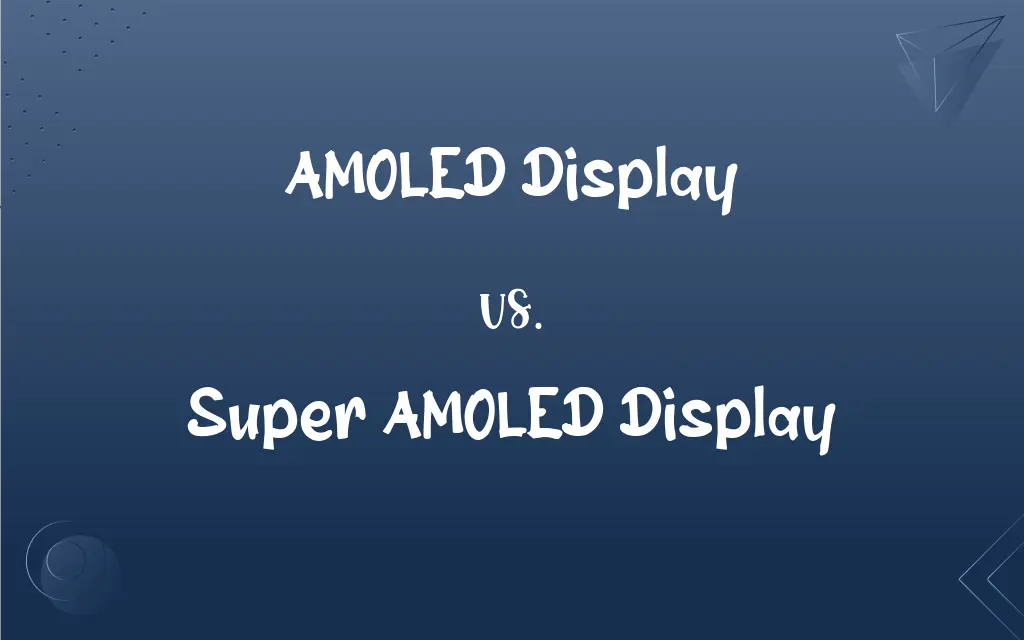AMOLED Display vs. Super AMOLED Display: What's the Difference?
Edited by Aimie Carlson || By Janet White || Published on February 26, 2024
AMOLED displays use an active matrix of OLED pixels for light and color, while Super AMOLED integrates touch sensors for thinner, more responsive screens.

Key Differences
AMOLED (Active-Matrix Organic Light-Emitting Diode) displays feature a thin-film transistor (TFT) array that controls each pixel's lighting. Super AMOLED displays, an advanced version, incorporate the touch sensor layer within the screen itself, reducing thickness and improving touch responsiveness.
In AMOLED displays, each pixel emits its light, offering deep blacks and high contrast ratios. Super AMOLED displays take this further by enhancing color reproduction and reducing sunlight reflectivity, offering a more vibrant and clear viewing experience even in bright conditions.
The energy efficiency of AMOLED displays stems from their ability to light individual pixels, conserving power when displaying dark colors. Super AMOLED displays optimize this efficiency with additional layers that also reduce power consumption, especially important for mobile devices.
Viewing angles on AMOLED displays are generally wide with minimal color shift. Super AMOLED displays improve upon this, offering even wider viewing angles and less color distortion, making them ideal for multimedia consumption and gaming.
Durability in AMOLED displays is commendable due to the absence of a backlight. Super AMOLED displays enhance durability by integrating the touch layer, making the screen less prone to damage and allowing for thinner device designs.
ADVERTISEMENT
Comparison Chart
Integration
Separate layers for display and touch
Integrated touch layer in the display
Thickness
Relatively thicker
Thinner due to integrated components
Color and Contrast
High contrast and color vibrancy
Enhanced color and contrast
Sunlight Visibility
Good visibility in sunlight
Superior visibility in bright conditions
Power Efficiency
Energy-efficient, especially in dark modes
More power-efficient than standard AMOLED
ADVERTISEMENT
AMOLED Display and Super AMOLED Display Definitions
AMOLED Display
It features individual pixel illumination for high contrast and deep black levels.
Watching movies on an AMOLED display provides an immersive experience with its contrast.
Super AMOLED Display
Offers enhanced brightness and color accuracy compared to standard AMOLED screens.
Photos look incredibly vivid on my phone's Super AMOLED display.
AMOLED Display
Known for its thin and flexible design, allowing for curved screen innovations.
The AMOLED display allows for ultra-thin designs in the latest wearable technology.
Super AMOLED Display
Features deeper blacks and higher contrast ratios for a superior visual experience.
The Super AMOLED display makes dark scenes in movies look incredibly deep and detailed.
AMOLED Display
Offers energy efficiency by lighting only active pixels, saving battery life.
My phone's AMOLED display is great for battery life, especially in dark mode.
Super AMOLED Display
More power-efficient than AMOLED, extending battery life in mobile devices.
I appreciate how my smartwatch's Super AMOLED display conserves battery.
AMOLED Display
Provides wide viewing angles with consistent color and brightness.
The AMOLED display on my tablet maintains clarity even when viewed from the side.
Super AMOLED Display
An advanced AMOLED with integrated touch sensors for a thinner profile and improved touch sensitivity.
The Super AMOLED display's responsiveness enhances my gaming experience.
AMOLED Display
A screen technology using organic compounds to create light when current passes through.
The smartphone's AMOLED display offers vibrant colors and deep blacks.
Super AMOLED Display
Provides better visibility in direct sunlight through reduced screen glare.
Reading e-books is comfortable on my Super AMOLED display, even outdoors.
FAQs
What is an AMOLED Display?
AMOLED is a screen technology that uses organic compounds to emit light when electrically charged.
Are AMOLED Displays energy-efficient?
Yes, they're more energy-efficient, especially displaying dark colors.
What does Super AMOLED Display offer?
Super AMOLED displays integrate touch sensors into the screen, providing thinner and more responsive displays.
Is Super AMOLED better than AMOLED?
Yes, it offers enhanced color, brightness, and touch sensitivity.
Are Super AMOLED Displays good in sunlight?
Yes, they offer better sunlight readability than AMOLED displays.
How does AMOLED Display work?
It uses a matrix of OLED pixels that emit light when electricity passes through.
Do AMOLED Displays have good viewing angles?
Yes, they provide wide viewing angles with minimal color shift.
Are AMOLED Displays used in TVs?
Yes, they're popular in high-end TVs for deep blacks and vibrant colors.
Do Super AMOLED Displays save battery life?
Yes, they're more power-efficient than standard AMOLED screens.
What's the lifespan of an AMOLED Display?
They typically last long but can experience burn-in over time.
Does Super AMOLED have burn-in issues?
Like AMOLED, it can experience burn-in, but technology improvements are reducing this risk.
Is Super AMOLED costlier than AMOLED?
Generally, yes, due to its advanced technology.
Do Super AMOLED screens have faster refresh rates?
They often feature high refresh rates for smoother visuals.
How thin are Super AMOLED Displays?
They are thinner than regular AMOLED due to integrated touch technology.
Is color accuracy better in Super AMOLED?
Yes, Super AMOLED displays have superior color accuracy.
Can Super AMOLED be used for flexible screens?
Yes, its technology allows for flexible and curved screen designs.
Can AMOLED Displays show true blacks?
Yes, because each pixel can be turned off completely.
How does AMOLED compare to LCD?
AMOLED offers better contrast and colors than standard LCDs.
Can AMOLED Displays reproduce HDR content?
Yes, they're capable of displaying high dynamic range content.
Is the touch responsiveness better in Super AMOLED?
Yes, the integrated touch layer makes them more responsive than standard AMOLED displays.
About Author
Written by
Janet WhiteJanet White has been an esteemed writer and blogger for Difference Wiki. Holding a Master's degree in Science and Medical Journalism from the prestigious Boston University, she has consistently demonstrated her expertise and passion for her field. When she's not immersed in her work, Janet relishes her time exercising, delving into a good book, and cherishing moments with friends and family.
Edited by
Aimie CarlsonAimie Carlson, holding a master's degree in English literature, is a fervent English language enthusiast. She lends her writing talents to Difference Wiki, a prominent website that specializes in comparisons, offering readers insightful analyses that both captivate and inform.































































